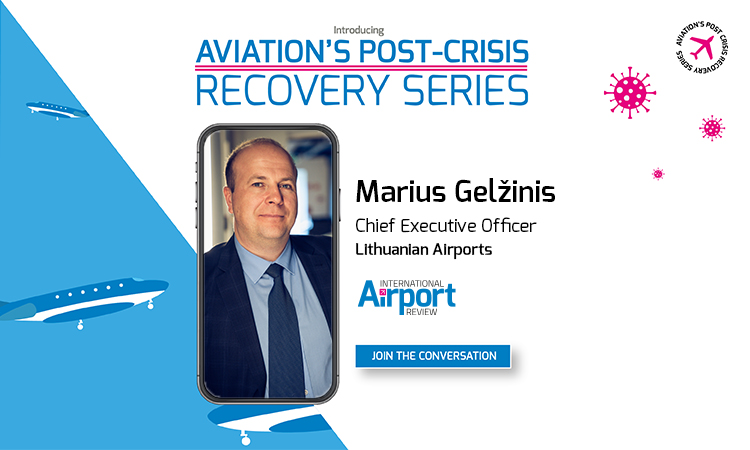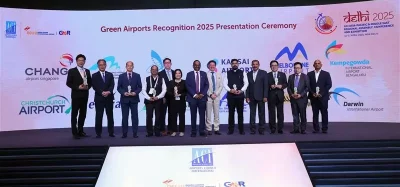Aviation’s Post-Crisis Recovery Series: Lithuanian Airports
- Like
- Digg
- Del
- Tumblr
- VKontakte
- Buffer
- Love This
- Odnoklassniki
- Meneame
- Blogger
- Amazon
- Yahoo Mail
- Gmail
- AOL
- Newsvine
- HackerNews
- Evernote
- MySpace
- Mail.ru
- Viadeo
- Line
- Comments
- Yummly
- SMS
- Viber
- Telegram
- Subscribe
- Skype
- Facebook Messenger
- Kakao
- LiveJournal
- Yammer
- Edgar
- Fintel
- Mix
- Instapaper
- Copy Link
Posted: 12 March 2021 | Marius Gelžinis | No comments yet
In the most recent instalment of International Airport Review’s exclusive series, Marius Gelžinis, CEO of Lithuanian Airports, is optimistic of the sector’s recovery post-COVID-19 as he evaluates the balance of passengers’ needs and desire to travel, while keeping safety as the highest priority.


The COVID-19 pandemic has been completely unprecedented in its impact on the aviation industry. How has it impacted Lithuanian Airports?
Without a doubt, 2020 was a period of the greatest challenges in the history of aviation. In 2020, 1.8 million people travelled through all three Lithuanian Airports – Vilnius Airport (VNO), Kaunas Airport (KUN) and Palanga Airport (PLQ) – which is 72 per cent less compared to 2019, and 30 thousand flights were served at the airports, which is 52 per cent less compared to 2019.
According to our forecasts, in 2021, we will manage to restore about half of the passenger traffic that we had in 2019″
However, studies show that demand for air travel is very high, peoples’ desire and need to travel persists. This implies a projection of sufficiently rapid recovery. According to our forecasts, in 2021, we will manage to restore about half of the passenger traffic that we had in 2019.
Other challenges also appeared during the pandemic – maintaining financial balance, securing essential work positions, continuing necessary expansion projects, investing into safety procedures and equipment and so on.
However, from what I see as a Board Member of Airports Council International (ACI) Europe, I can say that these are quite similar challenges that echo across all European airports. As I’ve said many times before – only by working together can we bring aviation back into the skies.
What immediate changes did you have to make in response to the pandemic, and what did you find the hardest problem to tackle?
We really need decisions which would unify and standardise Europe’s passenger movement requirements, and that is the way that we should all move in order to recover”
‘Changes’ might be quite a symbolical and very accurate term by which we could describe last year’s processes in aviation. I think one of the most challenging issues that started from the first quarter of 2020 and is keeping up until now is the various travel restrictions from country to country, which are still changing regularly. We really need decisions which would unify and standardise Europe’s passenger movement requirements, and that is the way that we should all move in order to recover.
Also, there were plenty of processes which were modified internally to adapt to the pandemic reality at Lithuanian Airports: we invested in safety measures, constantly adapting the infrastructure for the ‘new reality’ and implementing additional health checks inside our airports and so on.
What initiatives are you focusing on during 2021 to rebuild passenger confidence?
We strongly believe that providing the information about possibilities to travel safely will be one of the key elements in rebuilding passenger confidence”
Lithuanian Airports were one of the main information sources regarding travel restrictions for passengers locally, and we will keep it as our strategical goal in the near future. We strongly believe that providing the information about possibilities to travel safely, as well as educating about new processes and changes, will be one of the key elements in rebuilding passenger confidence.
There is no doubt that another essential part of our initiatives to get back passengers’ confidence are internal developments of processes and infrastructure to ensure that airports will remain to be seen as the safest choice for future travel.
What other exciting projects/developments are in the pipeline at Lithuanian Airports to help cope with increased passenger numbers once air travel begins to pick-up again?
There are two key developments at Lithuanian Airports: Palanga Airport’s runway reconstruction and the construction of a new departures terminal at Vilnius Airport. Both of those projects are planned to start in 2021. There are still some challenges, but we are searching for alternative ways to get the investments needed for these projects to be ready-to-go.
The new departures terminal at Vilnius Airport will increase the total area of Vilnius Airport’s terminals by one third, more than doubling passenger capacity from the current 900 to 2,400 passengers per hour. The project is necessary for increasing the capacity of Vilnius Airport, and that becomes even more relevant in adapting to the new challenges in the post-pandemic times regarding physical distance and passenger flow management.
Are there any initiatives that you have implemented during the COVID-19 pandemic that you will permanently integrate into your airports’ strategies, even once the crisis has passed?
COVID-19 testing and some type of health checks will likely be a part of air travel for a longer time”
It is difficult to say which of those processes will stay in post-pandemic times, but from what we see now, COVID-19 testing and some type of health checks will likely be a part of air travel for a longer time. That means that airports will need to adapt regarding this matter.
The importance of physical distance, various safety measures both for passengers and airport employees, disinfection solutions and the development of contactless travel processes might be the ‘new normal’, which will remain a part of the future aviation industry.
What business activity are you forecasting for Lithuanian Airports/ what is your business outlook?
The desire and necessity to travel is really building up in various markets and segments”
Although we faced a harsh winter season, there are some very positive tendencies that are arising. The summer 2021 season in Europe should bring us more confidence, as passengers flows will likely rise more rapidly. The desire and necessity to travel is really building up in various markets and segments.
Key elements, of course, will remain mass vaccination programmes and unified requirements for travel, which should be implemented internationally as soon as possible.
According to our forecast, Lithuanian Airports will restore half of usual (pre-pandemic) passenger flows during 2021. Although there are still some challenges in front of us, it is also clear that we performed well in terms of business processes, contingency planning and risk management.
Marius Gelžinis is the Chief Executive Officer of Lithuanian Airports, which operates Vilnius, Kaunas and Palanga Airports. He has a master’s degree in Public and Business Administration and has 11 years of managerial experience. Gelžinis is an aviation auditor and aircraft ground handling services instructor.
Related topics
Airport crisis management, Airside operations, Aviation's Post-Crisis Recovery Series, Capacity, COVID-19, New technologies, Passenger experience and seamless travel, Passenger volumes, Regulation and Legislation, Safety, Terminal operations
Related airports
Kaunas Airport (KUN), Palanga Airport (PLQ), Vilnius International Airport (VNO)
Related organisations
Airports Council International Europe (ACI Europe), Lithuanian Airports


















